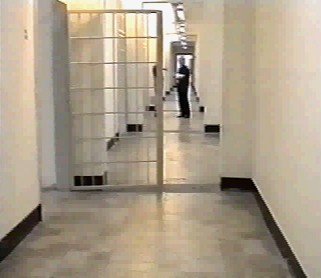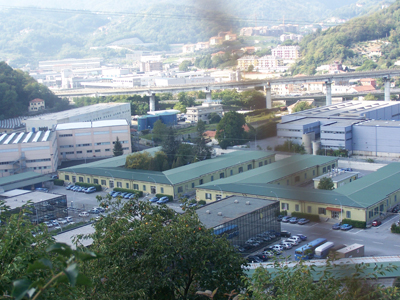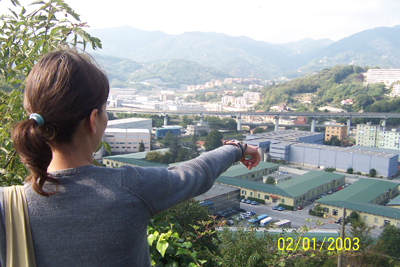INDYMEDIA - 12 March 2008. Genova: In a trial that has seen 209 victims, 392 witnesses and 23 defendants, The Bolzaneto G8 ‘Torture’ trial is finishing in a heated controversial ending.

Inside Bolzaneto

Bolzaneto in 2003

Bolzaneto revisited
A total sentence of 76 years and 4 months has been requested for 44 of the indicted. One defendant, Giuseppe Fornasiere was released. The five doctors and paramedics on trial also would face another total of 14 years. However, the court was plunged controversy when the prosecutors declared that they could not apply the maximum sentence penalty of 10 years against several of the defendants for ‘Torture’ because the Italian legal system did not recognise the crime of torture despite Italy being a founding signatory of the EU convention of fundamental human rights as enshrined by the ECHR and all EU member states.
The week before the court heard several judgments from the prosecutors who cited several cases from the European Court on Human Rights. One of them, the judgement of January 18, 1978, known to have touched on the so-called five technical harassment in the method of interrogation, described following the appeal presented by the Government of the Republic of Ireland against the Government of the United Kingdom. The case concerned ill-treatment had been the subject of people arrested during riots occurred between'71 and'72. "It emerged - explained the prosecutor - that those arrested were forced to stand against a wall in a 'position of power'; were hooded, subjected to continuous noise while being interrogated, deprived of sleep, food and beverages. "Of the five treatments examined by the Court and considered inhuman - says the prosecutor - four were certainly inflicted on Bolzaneto.”
"At least four of the five interrogation techniques used at Bolzaneto that, according to the European Court on Human Rights called upon to rule on the suppression of the riots in Ireland in the seventies, constituted" inhuman and degrading treatment".
“Victims arrested were forced to stand for hours, in inconvenient locations, beaten, taken around, deprived of food and water. The Prosecutor cited the UN convention banning torture and the inhumane, cruel or degrading treatment. The provision against torture, said the magistrate, Italy ratified had in 1989 but has not yet translated into a criminal law.”
According to the memorandum filed in March 2005 by the Genova Prosecutors office, Bolzaneto violated Article 3 of the European Convention of Human Rights, which prohibits torture and inhuman and degrading treatment.
The heaviest sentencing penalty was reserved for Antonio Biagio Gugliotta, Chief police Inspector and Head of Security at the G8 Bolzaneto Police detention Barracks. He is accused of abuse of office and abuse of authority against detainees. His sentence request is 5 years, 8 months imprisonment. Other senior police present were Deputy Police Chief (Turin) Anna Poggi (3 years six months), Carabineri Commanders Gianmarco Braini (2 years nine months) and Piermatteo Barucco (2 years and 6 months).
The penalty 3 years and 6 months' imprisonment was also sought in the case Alessandro Perugini, former 2 of DIGOS of Genoa, one of the most senior officers present in the Bolzaneto barracks. He is accused of abuse of office and abuse of authority against detainees as well.
General Oronzo D’oria in command of Penitentiary police at Bolzaneto and who was responsible for coordinating and organisation of the shift units during G8, received a sentencing request of 3 years and six months. So did Custody officers, captain Ernesto Cimino and Captain Bruno Pelliccia who were supposed to be responsible for the welfare of the prisoners.
Prosecutor Miniati recounted cases after case of the most violent episodes by some defendants against G8 prisoners. These include the snapping of each finger and then spraying in the face with teargas against Joseph Azzolina by Massimo Pigozzi. (Sentence request 3 years 11 months)
Senior police inspector Antonello Gaetano of the GOM mobile team beat French protester David Larroquelle, fracturing two ribs and forcing him to sign documents he did not understand. Gaetano was also responsible for one of the most infamous Bolzaneto torture ‘techniques’. He humiliated Mark Bistacchia by forcing him to kneel on all fours, bark like a dog and force him to shout ‘long live Il DUCE’. He receives a sentencing request of 1 year and 4 months.
Turkish prisoner Ester Percivati was ‘waterboarded’ with her head shoved town a toilet by agent Barbara Amadei. She receives a sentencing request for 10 months.
Five doctors and paramedics of the Bolzaneto penitentiary administration, including the head Provisional prison health of the G8, James Toccafondi were also sent sentencing requests. Toccafondi is accused of breaching the EU convention on medical ethics protecting human rights and fundamental freedoms. He is also accused of acts of abuse which included several beatings, insults and violence. He also cut off the hair of the women prisoners and kept their hair as ‘trophies’. He received 3 years and six months. Aldo Amenta - 2 years eight months. Sonia Sciandra- 2 years, 8 months, Marilena Zaccardi-2 years 3 months and Adriana Mazzoleni -2 years 3 months.
As their final act for the prosecution case, Italian state Prosecutors Patrizia Petruzziello and Vittorio Ranieri laid before a court a request that the defendants pay five million Euros compensation to the victims (what will happen is that the Italian taxpayer will shoulder the compensation claims with the defendants paying back this money either in money or sentence).
Many Bolzaneto victims and the Genova Legal Forum stated that there was no justice in Italy on the question of torture and that Lawyer Dario Rossi would be applying to the ECHR court for so that ‘torture’ charge could be brought against several defendants. The victims also cited that the Bolzaneto sentencing requests were not particularly high given the severity of the crimes. In the Genova trial of 25 protesters, which delivered its verdicts in December, some protester defendants were given eight years for breaking a window or throwing a stone.
The GLF stated that there seemed to be one special kind of G8 law being applied to protesters which brought heavy sentences for small crimes whilst another kind of law applied to the police which almost gave them immunity to endanger and torture G8 victims and prisoners.
Given the severity of the verbal judgment on the issue of torture, calls for the Diaz parliamentary inquiry were issued by the GLF and most of the Italian left wing parties. Walter Veltroni, the current left wing candidate for the Italian elections said in a letter to the Genova Mayor Vincenzi Marta,
“With regard to the need for incorporating italy’s responsibility for the EU convention against Torture, this issue will be very high on the agenda of the next parliament”. He also said that “an inquiry must be constituted to discover which politicians were responsible for ordering the systematic torture at Bolzaneto and also for us to learn the lessons of the Diaz raid so both episodes can never happen again”.
In Conclusion, it seems that the Guantanamo torture techniques were practised at Bolzaneto before 9-11. It also seems clear that the history of these techniques were invented during the Northern Ireland troubles, probably before. For the victims involved, the nightmare does not finish even if Bolzaneto does. Its verdict is due at the end of June whilst the Diaz case final arguments are scheduled for May/June 2008 with its verdict in October. Only then the Italian Interior ministry accepts responsibility for Diaz will the civil compensation claims be activated. It is expected that most of the Bolzaneto defendants will appeal. The victims will have to wait until Dec 2008 to find out whether any have been granted. If appeals are turned down, the defendants will start entering the prison system in early 2009.
Background to the G8 Bolzaneto Barracks trial.
“When we dragged them from the cells inside the Bolzaneto police barracks, we beat them”. The two penitentiary policemen confessed in January 2004 for violence against G8 protesters arrested during the G8 summit in 2001. The moment was a turning point for prosecutors Patrizia Petruzziello and Vittorio Ranieri Miniati who had been investigating the alleged abuses and torture since the spring of 2002 and in tandem with its sister trial, the Diaz school raid.
On the 11th of May 2004, 47 GOM Penitentiary police and Carabinieri were indicted (charged) and sent for trial. As for the confession of the two prison police, their statements led to General Oronzo D’Oria also being put on trial. D’Oria was in charge of the shift units on duty during the five day period where 209 arrested people passed through. None were ever charged and were released in the days and weeks after the G8.
The charges were:
Abuse of authority
Abuse of office and false ideology
Forgery,
Breach of the penitentiary regulations
Since May 2004 the accusations became heavier with the addition of:
Private violence (common assault)
Personal injury and beatings
Failure to inform authorities, relatives and foreign embassies.
Denial of basic legal rights
EU Convention for the Protection of Human Rights and Fundamental Freedoms
On 12 October 2005, the Bolzaneto trial officially got underway. Of the defendants, fourteen are belonging to Police Penitentiary, twelve are Carabinieri, including commanders Giammarco Braini and Barucco Piermatteo; fourteen are agents and officials of the State Police, beginning with Deputy police chief Alessandro Perugini, deputy head of the Digos at Genoa (now on trial for the assault of a child demonstrator) and the inspector Anna Poggi, deputy police chief of Turin.
Bolzaneto victims began to arrive Saturday 21st July 2001. Lega Nord justice minister Roberto Castelli visited Bolzaneto on that Saturday afternoon with a group of Allianze Nationale parliamentary members, performed an ‘official prison inspection’ and then spoke to the GOM and Carabineri men. Prosecutors believe that it was he who “set the conditions for the torture at Blozaneto”. Testifying in 2006 and when he was facing the political blame for Bolzaneto, Castelli told the court that Gianfranco Fini had ordered him to visit Bolzaneto. Bolzaneto was to process 209 prisoners in the five days it was used as a transit detention centre. So far, Fini has not been questioned by either trial into his involvement. Diaz victims maintain he is responsible for ordering the Diaz raid and arranging the torture at Bolzaneto.
In the early hours of Sunday 22nd and over the next 24 hours, some 81 Diaz victims were transited to Bolzaneto. Over 50 had been dragged from their hospital casualty beds despite the protests of doctors and no court order authorising such removal. Amongst the Diaz victims were four british victims. They were Richard and Nicola Docherty, Dan Macquillan and Norman Blair. The fifth victim, Mark Covell was on a life support machine in San Martino Hospital. Already in poor shape, many Diaz victims were specially labelled and were then singled out.
Some members of the local Police and Penitentiary State Police including Daniela Cerasuolo (8 months) and Massimo Solomon (7 months). From their testimonies have emerged ever more clear details:
A "Welcome" sign greeted prisoners on arrival. They were then taken to the two wings of Bolzaneto which was reserved for prisoners. As they entered each wing, two lines of police would deploy and the prisoners were forced to walk the kickline taking kicks, punches and batons. Injuries were left untreated.
A GOM policeman’s testimony
“I walked into one of the cells which including the wounded, all were forced to keep their hands raised backed to the wall, the face turned to the wall and legs apart. After many hours this position created severe pain and cramps, but anyone who tried to move was beaten by agents guarding the cells.”
Dramatic, in this sense, is what happened to (on 6 November 2007) a disabled person who was arrested during G8, which was confirmed by several fellow Italians and foreigners. The victim was 52 years old and had a plastic false leg. He had been standing for many hours without food or water against the wall in a stress position when he collapsed onto the floor. Carabineri and penitentiary police kicked and beat him with batons all over his body until he was forced to stand up again against the wall.
Others had to undress completely and then forced to do endless press-ups in front of many police.
Prosecutors were shocked to discover that a dazed polish protester with an undiagnosed skull fracture was also beaten in Bolzaneto. He had come from the notorious Diaz raid that had occurred overnight Saturday-Sunday morning, July 21/22nd 2001. Of the 209 prisoners, 81 were from Diaz. Already in poor shape, many were singled out.
According to Sara Bartesaghie, a 21 year old protester and other prisoners, teargas sprays was repeatedly used against prisoners inside the cells to immobilize and to suffocate prisoners. The Bolzaneto directors Enrico Ragosa, and Gen. Nicola Agnano confirmed that teargas sprays was neither authorized or supplied to GOM penitentiary police. On 9 January 2007, General Ricci Mattiello, head of the translation service and the departments of GOM Penitentiary at G8 said he did not exclude that agents - probably younger – did use personal teargas sprays.
The defendants testify
One of the main defence arguments was to state that there had been alot of confusion and that everyone thought it was someone else’s responsibility to feed the prisoners or look after their health.
The attitude of the defendants, called to testify by the prosecutor and defence attorneys from the beginning of 2007, was generally 'sealed' and not very cooperative. Many of the Carabinieri, Police and Penitentiary Police State stated that they had never entered the cells, or never being in a particular location for long enough to see abuse or to hear the insults. Others have openly minimized the facts, describing certainly a situation of tension, especially among younger officers, but saying they not recall any major event outside the normal routine.
The most striking testimony is from witness protected F. M., now accused of false testimony by the defence for the statements made in court on 07 May 2007.
This witness was particularly important. He explained during the hearing, of his constant presence in the three days inside the Bolzaneto barracks as a member of a Special Police Penitentiary GOM unit and their participation in the events.
The GOM was created in 1997 "to meet the needs arising from the management of detainees belonging to organized crime", "contribute to the security of detainees deemed high hazard" and take "appropriate measures to prevent and stop facts or circumstances prejudicial to the order and discipline of prison.
The teams present at Bolzaneto, led by dall'Isp. Reale, formed up in the courtyard awaiting the arrival of prisoners. Gen. Mattiello, head of the service, spoke in court on 09 January 2007 and stated that GOM agents should of stayed in the courtyard but instead often entered in the barracks and he remembered the ‘notorious kickline corridor’. He went onto recount the stories that reveal the extent of the violence.
With the list of prosecution witnesses also finished by the end of February, on 2 March 2007 an inspection of the barracks was carried out by the judges, Genoa Legal forum lawyers and state prosecutors.
Consultants, doctors and psychiatrists, including Dr. Monaco (12 March 2007) were called to testify on the stress and amount of violence inflicted. He explained how the prisoners who had suffered such violence within the barracks would be dealing with "disturbing post-traumatic stress disorder, similar to that caused by unpredictable situations such as natural disasters: but the human violence, the doctor concluded, causes more damage, because the trauma stems from injury or witnessing fellow human beings in act of abuse and torture.
On 17 September 2007, Bolzaneto resumed after a summer break and heard 23 of the 47 accused. Among those who had decided to undergo the examination was Dr. Toccafondi. At the same time of being called to Bolzaneto, he is indicted for killing a Genova patient in 2006.
Bolzaneto penitentiary police agent Pigozzi also testified. He was placed under house arrest for raping several young girls at police headquarters in Genoa in 2005. Plaintiffs believe he is the source of threats of rape against women arrested during the G8.

